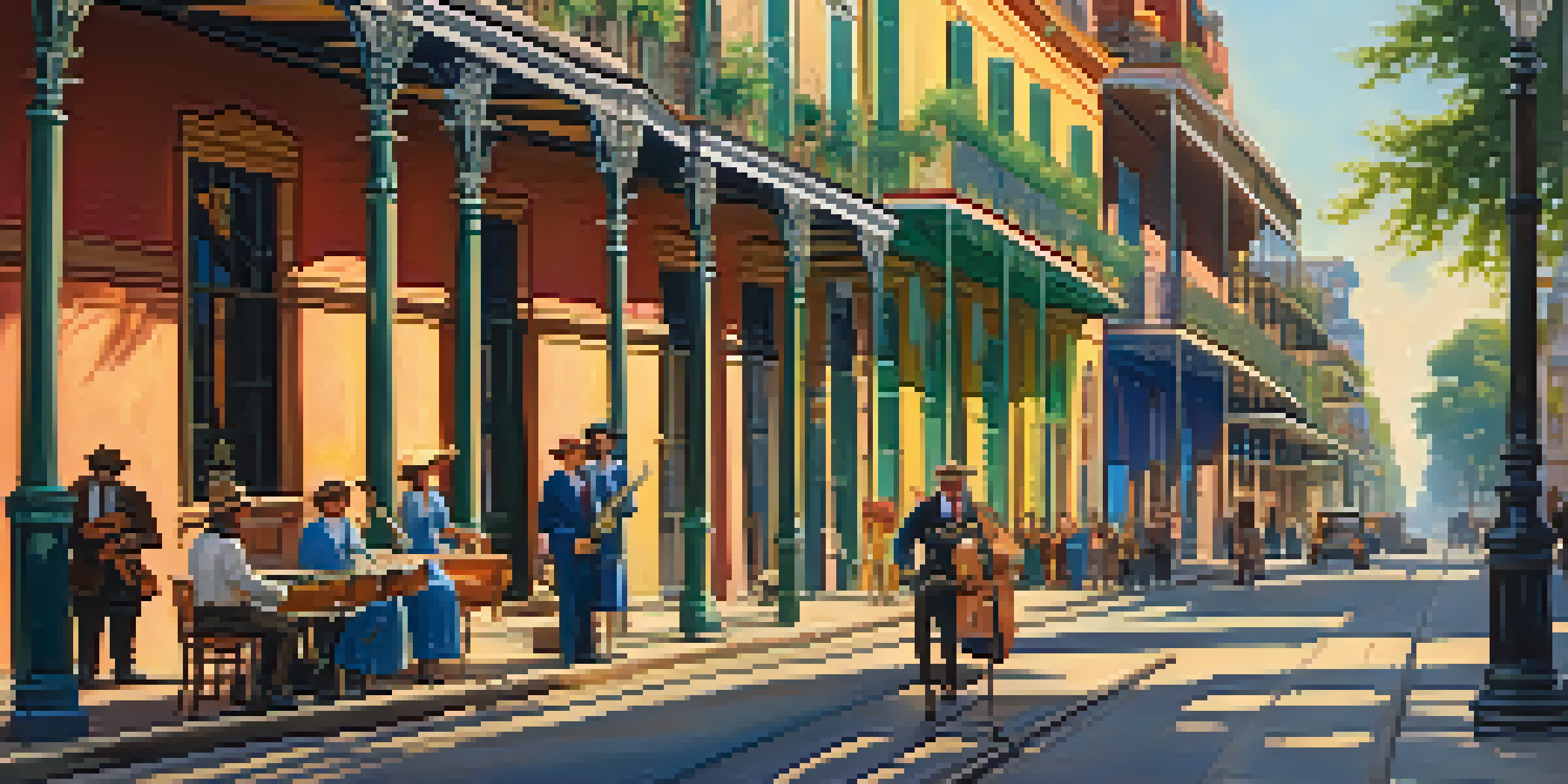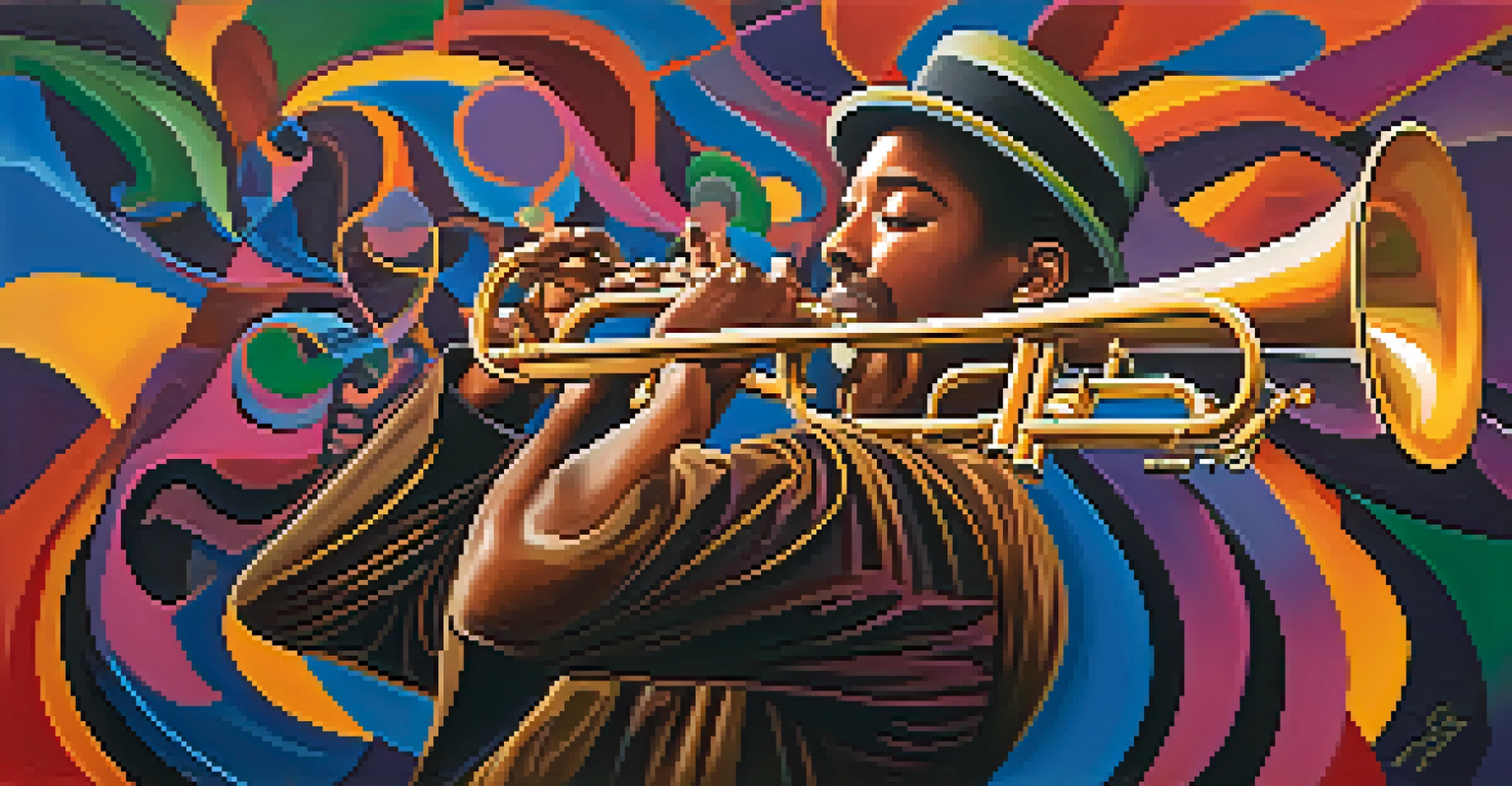Art and Literature: The Legacy of the New Orleans Renaissance

What Sparked the New Orleans Renaissance Movement?
The New Orleans Renaissance, emerging in the early 20th century, was fueled by a unique blend of cultural influences. It was a time when jazz, Creole traditions, and African American experiences converged, creating a fertile ground for artistic expression. This vibrant atmosphere motivated artists and writers to explore new themes and styles, pushing the boundaries of traditional art and literature.
Jazz is the big brother of the blues. It's the sound of the city, the sound of life, and it has the power to inspire creativity across all forms of art.
During this era, the city became a melting pot of creativity, where local musicians, poets, and painters began to redefine their crafts. The influence of jazz music, with its improvisational spirit, seeped into literature, inspiring authors to adopt a more fluid and dynamic narrative style. This interconnectedness between different art forms played a pivotal role in shaping the Renaissance.
As artists sought to capture the essence of life in New Orleans, they created works that reflected the struggles and triumphs of their communities. The legacy of this movement is still felt today, as it laid the groundwork for future generations of artists who continue to draw inspiration from the rich cultural tapestry of the city.
Key Figures of the New Orleans Renaissance
Among the prominent figures of the New Orleans Renaissance, Langston Hughes stands out as a literary giant. His poetic works, infused with jazz rhythms, celebrated the African American experience and challenged societal norms. Hughes's ability to capture the spirit of the era through vivid imagery and heartfelt themes resonates even today, showcasing the power of literature to inspire change.

Another notable figure was artist and musician Louis Armstrong, whose contributions transcended music and influenced visual artists and writers alike. Armstrong's innovative approach to jazz not only transformed the music scene but also inspired poets to incorporate musicality into their verses, creating a symbiotic relationship between the two art forms.
Cultural Fusion Fuels Creativity
The New Orleans Renaissance thrived on the blending of jazz, Creole traditions, and African American experiences, inspiring artists to push creative boundaries.
Lastly, the playwright and novelist Zora Neale Hurston played a crucial role in documenting the culture and folklore of African Americans in New Orleans. Her works, rich with local dialects and traditions, provided a voice to marginalized communities and emphasized the importance of cultural heritage in literature.
The Role of Jazz in Shaping Literature
Jazz music emerged as a powerful force during the New Orleans Renaissance, influencing writers to embrace its improvisational elements in their storytelling. The syncopated rhythms and spontaneous nature of jazz encouraged authors to experiment with narrative structures, leading to more fluid and innovative forms of expression. This blending of art forms created a unique literary style that captured the essence of the era.
Art must be an integral part of our lives; it must reflect our struggles, our heritage, and our desire for freedom and expression.
Writers began to draw parallels between the emotions evoked by jazz and the themes they explored in their works. Just as a jazz musician improvises, authors started to play with language, crafting sentences that flowed with a musical quality. This connection between jazz and literature not only enriched the storytelling experience but also deepened the emotional impact of their narratives.
Moreover, the themes of struggle and resilience found in jazz music resonated with the experiences of many writers during this period. By weaving these themes into their stories, authors were able to reflect the complexities of life in New Orleans, creating a lasting legacy that continues to influence artists today.
Cultural Influences: African American Heritage
The New Orleans Renaissance was profoundly shaped by the African American heritage that permeated the city. This cultural foundation provided artists and writers with a wealth of stories, traditions, and experiences to draw from, enriching their work in remarkable ways. Celebrating their roots, these creators explored themes of identity, community, and resilience, reflecting the vibrant life around them.
Folklore, spirituals, and oral traditions became significant sources of inspiration for many writers, allowing them to convey the unique narratives of their communities. By incorporating these elements into their literature, they not only preserved their cultural heritage but also introduced readers to the richness of African American experiences in New Orleans.
Jazz Influences Literary Style
Jazz music's improvisational nature encouraged writers to adopt fluid narrative structures, enriching the storytelling experience.
This celebration of African American culture during the Renaissance also fostered a sense of pride and empowerment within the community. As artists embraced their heritage, they contributed to a broader understanding of the complexities of race and identity, paving the way for future generations to explore these themes in their own work.
Visual Arts: The Birth of New Orleans' Unique Style
Visual arts flourished during the New Orleans Renaissance, showcasing a distinctive style that blended various influences. Artists drew inspiration from the vibrant street life, architecture, and the rich cultural tapestry of the city, resulting in works that were both visually striking and culturally significant. This unique amalgamation of styles helped to define the artistic identity of New Orleans.
The use of bold colors, dynamic compositions, and innovative techniques became hallmarks of the New Orleans visual art scene. Artists like Archibald Motley and John T. Scott embraced the city's energy, translating it onto canvas through their expressive works. This emphasis on individuality and cultural pride resonated with audiences, further solidifying the Renaissance's impact on the art world.
As artists pushed the boundaries of traditional techniques, they invited viewers to experience New Orleans in new and exciting ways. The visual art created during this period not only served as a reflection of the times but also laid the groundwork for future artistic movements, ensuring that the legacy of the New Orleans Renaissance would endure.
The Impact of Literature on Social Change
Literature from the New Orleans Renaissance played a vital role in advocating for social change, challenging the status quo and addressing pressing issues of the time. Writers used their craft to shine a light on the struggles faced by marginalized communities, sparking conversations about race, identity, and equality. This activism through literature laid the groundwork for future movements seeking justice and representation.
Through powerful narratives, authors not only depicted the realities of life in New Orleans but also inspired readers to reflect on their own beliefs and values. By addressing social issues head-on, they encouraged a sense of empathy and understanding among diverse audiences, fostering a greater appreciation for the richness of different cultures.
Legacy of Social Change in Literature
Literature from the New Orleans Renaissance advocated for social change, addressing issues of race and identity that resonate in today's discussions.
The legacy of this literary activism is evident today, as contemporary writers continue to draw inspiration from the works of their predecessors. Their commitment to using literature as a tool for social change ensures that the voices of marginalized communities remain heard and valued in the ongoing fight for equality.
The Lasting Legacy of the New Orleans Renaissance
The New Orleans Renaissance left an indelible mark on both art and literature, shaping the cultural landscape of the city and beyond. Its influence can still be felt today, as modern artists and writers draw inspiration from the themes, styles, and narratives established during this vibrant period. The legacy of this movement continues to resonate, encouraging new generations to explore their creativity and cultural heritage.
By fostering a sense of community and collaboration among artists, the Renaissance created a support system that allowed for the flourishing of diverse voices. This emphasis on collaboration remains a hallmark of New Orleans' artistic culture, where artists from various disciplines continue to come together to create and innovate.

Ultimately, the New Orleans Renaissance serves as a reminder of the power of art and literature to inspire change and promote understanding. Its legacy is not just a chapter in history; it is a living, breathing testament to the resilience and creativity of a city that continues to celebrate its unique identity.